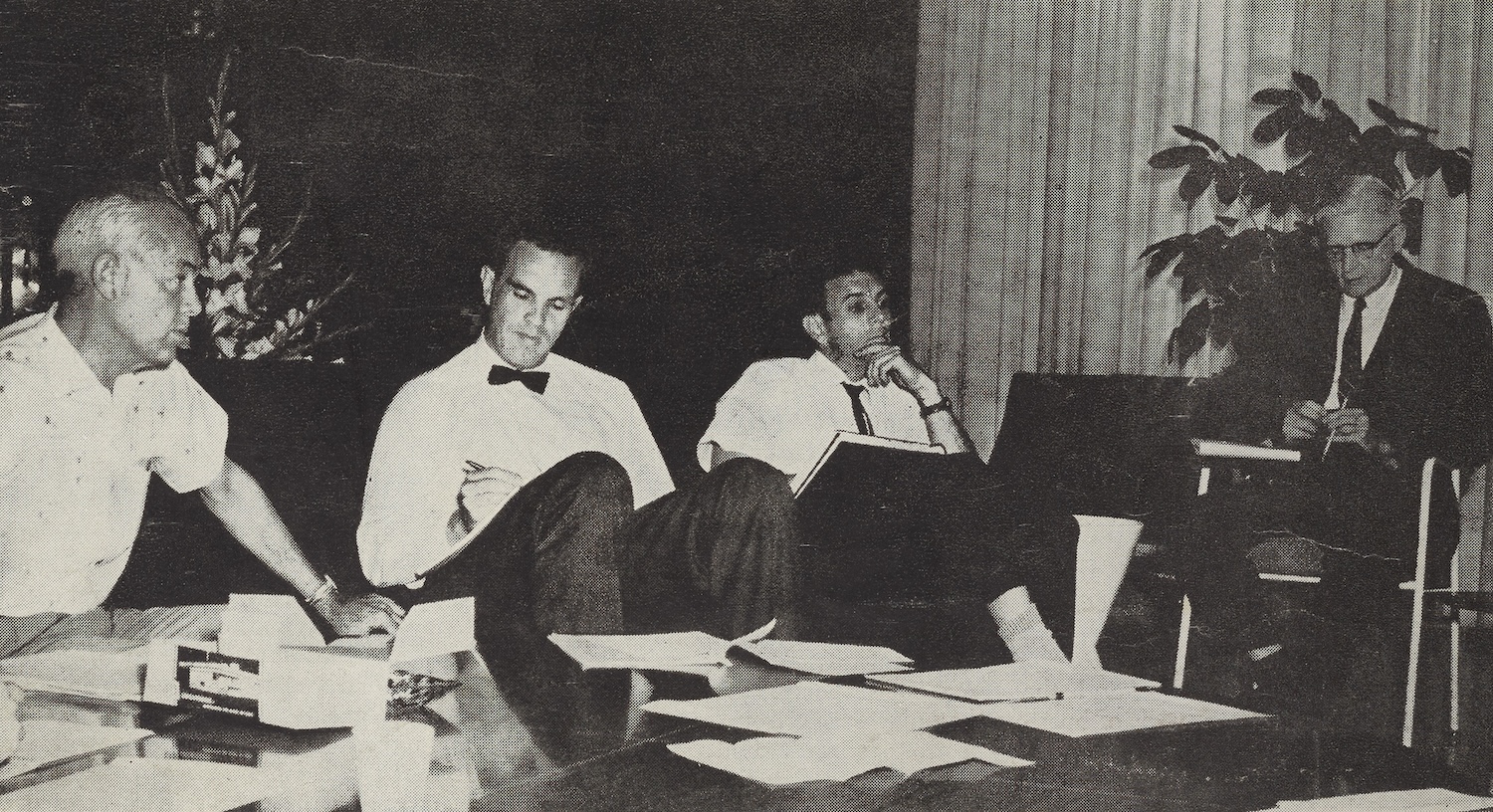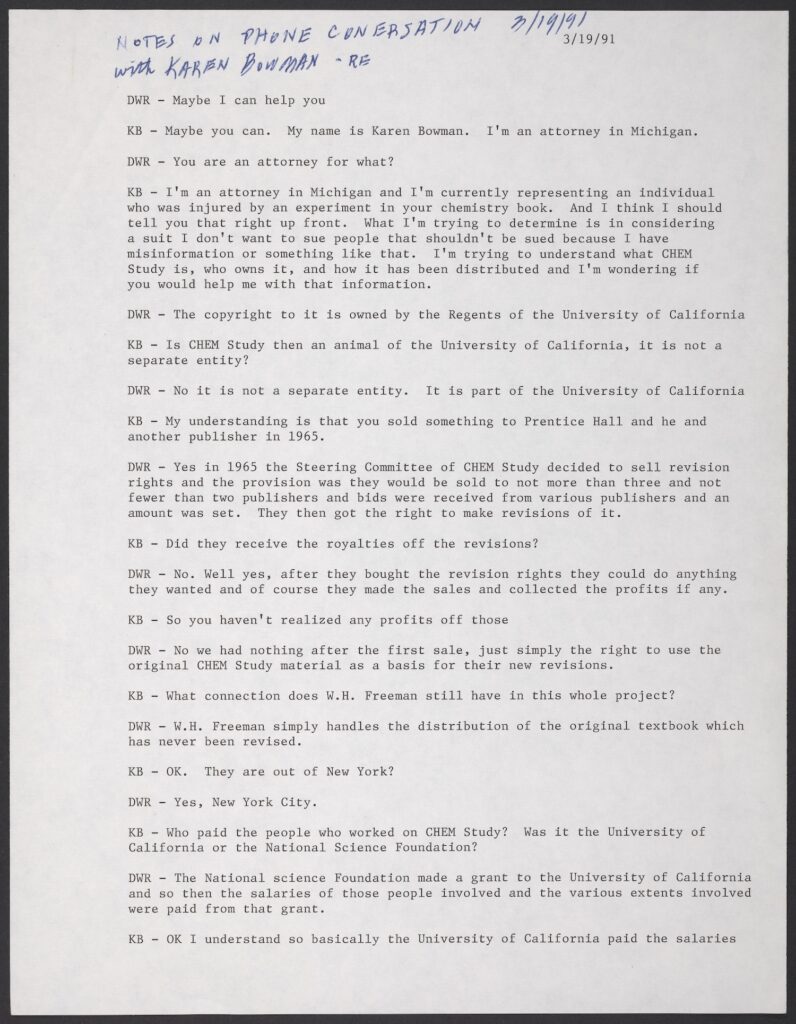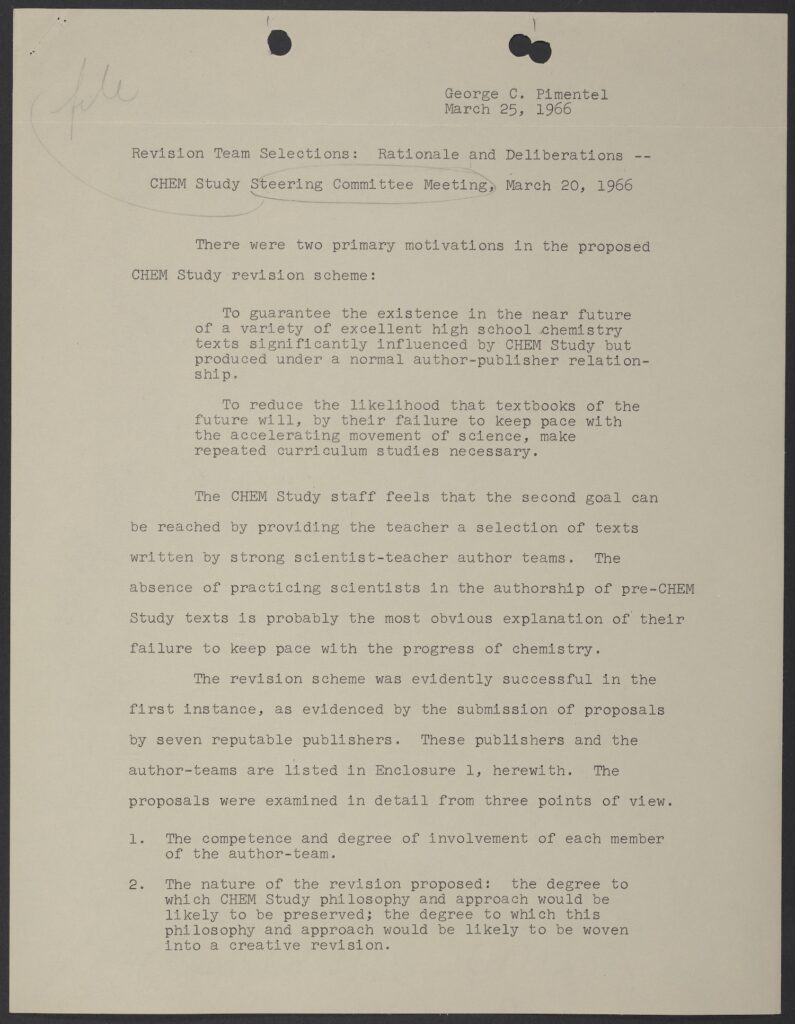The Life and Times of CHEMS
A chemistry curriculum with bonds beyond the molecule.

A chemistry curriculum with bonds beyond the molecule.
The late 1950s and early 1960s were a period of active ferment in U.S. high school education. Between 1957 and 1962, scientists and science educators from universities and high schools around the country collaborated to produce rigorous and up-to-date math, physics, biology, and chemistry curricula. This work was supported by the newly established National Science Foundation (NSF), which was created at the close of World War II in recognition of the crucial role scientists played in the Allied victory.
The Science History Institute has a lot of materials related to two of these NSF-funded high school science curriculum projects: the Chemical Bond Approach (CBA) and Chemical Education Materials (CHEM) Study. Both were highly theoretical and “discovery based,” meaning they were structured so that students could learn course concepts through their own guided experimental work in the lab. They were offered as correctives to an older curriculum that was based on rote memorization and limited to “classical” discoveries, which reformers worried were increasingly out of step with the science that won the war.

We are two historians—a curatorial fellow and a research fellow in residence—who have converged on these materials in the reading room of the Institute’s Othmer Library. Our experiences with the CHEM Study collections, which also include the papers of local high school teacher Joseph S. Schmuckler, highlight the fact that archives aren’t just about collecting heaps of stuff; they also curate relationships among people. With this idea in mind, we thought we’d share a little bit in the dialogue below about our interests in these collections.
Judith Kaplan: Jim, what drew you to these materials in the first place?
Jim Wynter Porter: Thanks, Judy. I’m really interested in these materials because they offer a way of assessing how rapidly curriculum and educational opportunities were changing at mid-century. But they also help me ask questions about who actually got access to this new enriched science curriculum.
So, there’s an enormous amount of development in educational policy between the mid 1950s and early 1960s. Because of this, I think we need to consider these NSF curriculum projects as one part of a larger policy complex that includes its very near predecessors: the 1958 National Defense Education Act (NDEA) and then also, just before that, the 1954 Brown v. Board Supreme Court decision that ended legalized racial segregation of schools.
When you look at this policy complex as a whole, you can see links between these rapid changes in curriculum and opportunity as well as the making and re-making of institutional racism (and classism) in public education.
JK: Can you say a little more about how these pieces fit together for you?
JP: So the NDEA gave schools money to strengthen secondary science instruction under the assumption that this would help the U.S. maintain technological competitiveness in the context of the Cold War. And the NDEA’s passage followed right on the heels of the Sputnik launches. Because of this, it has gone down in history as a U.S. response to the perception that the Soviets were winning the “space race.” But the NDEA was about more than “strengthening” science instruction. It also laid out funds to expand standardized “ability” testing and guidance in high schools. This would make it possible, it was argued, for schools to identify the “brightest” students for rigorous science classes and prepare that select group for college-level study.
JK: So, what do these policies have to do with Brown?
JP: Planning for the NDEA actually began in early 1955, well before the Sputniks and just months after the 1954 Supreme Court decision to end segregation. Brown was to usher in a new era of equality in schooling, and it came after generations of the starkest kinds of racial educational inequality. Brown also provoked swift and enduring white backlash that manifested in obvious and not-so-obvious ways.
If you step back and look at this remarkably eventful five years—not piecemeal, but all together—the NDEA and NSF reforms were not only offering U.S. public schools resources to improve science curriculum, they were also separating students and differentiating opportunities internally according to measured “ability.” And they were doing this just as schools were impelled to desegregate by “race.” Because of generations-long educational disparities produced by segregation—and also well-established biases in testing by “race” and class—such testing and “ability”-centric policy could readily recreate educational inequalities by “race” and by class.
JK: Are you seeing evidence of those issues in the materials we have here?
JP: Yep, the measured “ability” of prospective students was definitely an important criterion in planning and evaluating the CHEM Study. It’s also clear that planners hoped the curriculum would help students bound for college take that next step. But there’s also evidence that what counted as sufficient “ability” could be contestable or negotiable. Experts with the NDEA proposed pretty strict thresholds for entry into high school sciences.
For example, James Bryant Conant, who was conducting a study in under-resourced and more diverse schools across the Northeast and Midwest, argued that only the top 15% in terms of measured “ability” had what it took for college-prep math and science. The CHEM Study curriculum writers—two years later—suggested relaxing this threshold. They referred to the very same test of ability Conant had based his benchmarks on, but here they argued their curriculum was suitable for the top 50% of all high school chemistry students.
This wasn’t the kind of hard barrier-to-entry that Conant was proposing. It was more a statement about who would likely succeed in the course. At the same time, this “top 50%” is actually a more stringent demarcation than it might seem at first. “All high school chemistry students” was already selective to begin with. National enrollment numbers from the 1950s and 1960s consistently indicated that under 15% of the total student body elected to take chemistry. But I think this CHEM Study framing of “ability” opened up more discretionary wiggle room. It referred to “ability” test benchmarks while offering more moderate-seeming parameters. Yet these applied to a more select group, but a group defined in part by student choice!

In the end, I think, this all indicates how much would be left up to schools. Schools could choose the Conant approach if they liked or opt to weigh multiple criteria. They now had well-respected experts counseling either course. And remember this all came with federal dollars for more “ability” testing. Schools were being given resources, options, and justifications for structuring and limiting access in the way they saw fit—and this could vary by neighborhood, district, or region. So, then map this flexible approach back onto varying regional politics and strategies for maintaining racial status quo.
It seems important to mention on this score that CHEM Study appears to have been piloted and debuted in generally better-resourced and less diverse (i.e. more “white”) school systems. But all this amounts to a working theory. Getting a clearer picture of what was actually happening would involve school-based analyses that are comparative by region.
JK: This helps contextualize the observations I’ve been making on the CHEM Study itself.
JP: Tell me more!
JK: I first learned of it when I was working on a biography of Robert W. Parry, who I knew had been involved in some way. I was looking for Institute holdings that would help round out my understanding of his career, and was thrilled to find that we had the CHEM Study Records here on site. Parry’s name didn’t come up that often. He was given editorial credit for his work on the initial 1960 draft, and then he surfaced again in some documentation of a lawsuit decades later.

JP: Oh yeah?
JK: It involved a Michigan highschooler who was burned trying to do a CHEM Study experiment. I was confused at first when I saw this, like, why were they going after this guy who seems pretty peripheral?
JP: I hadn’t thought about the lab safety angle. But right, why single out Parry? And how does this all carry on into the 1990s?
JK: Turns out, Parry was being sued personally because this student had been using his revision of the original CHEM Study text. I started to see how plans were made for the curriculum to take on a life of its own through private market-based revision and development. So my interests as a biographer moved from Parry to CHEMS itself.
JP: Ah, I didn’t know that. But what are you finding about how the curriculum got off the ground in the first place?
JK: The birth and “childhood” of the project date back to the end of 1959—though, I realize you would put its origins a few years earlier! Chemists Glenn Seaborg, Arthur Campbell, and George Pimentel held a workshop for high school teachers and university researchers at Harvey Mudd College in the spring of 1960. Their goal was to hammer out this new experimental approach to chemistry instruction. I was struck by how quickly they managed to do this!
After an initial four-day meeting, they reconvened for just six weeks over the summer, and they were actually able to write a whole textbook and lab manual in that time. Consensus had to be forced, in some cases, but they got it done. The first draft was ready for the start of school in September. Teachers at pilot schools met weekly that first year to offer feedback to Campbell, the first director, and his team. This feedback informed the second revision, and then the third, by which point the curriculum had reached some level of maturity. Supplementary films were released about this time. They helped make the curriculum more flexible, as you were saying, and ended up generating a lot of revenue.
JP: This is a nice picture of how the curriculum was developing in its early stages. And, I think your observations about the speed and pace of things is crucial.
JK: Beyond speed, the other thing that struck me about the “early life” of CHEMS was that it was all experimental, all the time. Not only was the curriculum itself celebrating experimentation as the best way to teach science, but there were also all of these novel efforts at program evaluation. Not to mention the broader sense that the CHEM Study was being tested against the Chemical Bond Approach.
JP: “Experiment” as a total educational philosophy! I think there’s a lot of innovative stuff going on here pedagogically. You can look at these policies from a strictly Cold War science education perspective and get this image of heroic progress and development. But if you draw Cold War and Civil Rights perspectives together, you can start to ask other questions: who’s included and who’s more likely to get left behind in this modernization project? So how does CHEM Study continue to develop through the 1960s?
JK: By about 1963, the CHEM Study had reached young adulthood. David Ridgway, who donated his CHEMS Records to the Institute, was taking over the executive directorship—what had been basically a principal investigator role under Campbell was turning into more of a CEO position. Plans were being made for its future independence. I saw this in the minutes of the CHEM Study Steering Committee. A sub-committee, the “Revision Team,” got together in 1966 to entertain proposals from several teacher-researcher-publisher teams. The idea was that after several years of intensive cultivation, the curriculum worked. It had been widely adopted and teachers were reporting high levels of student satisfaction. But it would need to keep up with ongoing developments in experimental chemistry to keep working.
The Steering Committee ended up endorsing three “authorized revisions,” one of which was Parry’s, putting these in competition with each other to stay relevant. I’ve really enjoyed thinking about both the hubris and the humility in that arrangement—this sense that the planners knew their own work would be superseded.

JP: Yeah, it’s this “We’ve done this, now let’s get out of the way” attitude. What comes next?
JK: By 1969, the CHEM Study was, as Seaborg put it, in the “unprecedented position of more than paying for itself.” The money that the project took in from sales and licensing of its materials (products that were acquired, circularly, with NDEA grants) exceeded initial federal inputs for research and curriculum development. Apparently, this is rare! The millionth copy of the original (pre-revision) textbook was celebrated in 1983. But by this time, Ridgway was worried that CHEMS had lost its audience. Plans were in the works for reissuing several of the films, but leadership did not expect they would sell enough to break even. They decided to close shop not long after.
JP: These different life stages of the curriculum seem so American: the market figures as the source of innovation, not government. Was there a highlight for you?
JK: I just love that we have Schmuckler’s notes on the draft curriculum. It’s such a valuable window into how this thing was put into practice. What about you?
JP: Maybe watching the films. Most of them are online and the Institute is currently digitizing the rare versions we have in languages other than English. They’re fascinating in how they try to capture sensory elements of experiments that couldn’t be done in the classroom.
I’ve really enjoyed this conversation with you, Judy, and hearing about what you’re discovering. It’s opened up whole aspects of this curriculum development project I hadn’t considered before. Thank you!
JK: Thank you!
Featured: Animation from The Hydrogen Atom—As Viewed by Quantum Mechanics (advanced version), video published by CHEM Study, College of Chemistry, UC Berkeley, 1963.
How to read a book when the pages are out of order.
An Institute fellow sheds light on an enigmatic trio.
We’re still scratching our heads over how the brain works.
Copy the above HTML to republish this content. We have formatted the material to follow our guidelines, which include our credit requirements. Please review our full list of guidelines for more information. By republishing this content, you agree to our republication requirements.